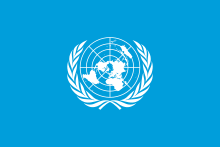Millennium Development Goals

The Millennium Development Goals (MDGs) are the eight targets of the United Nations. They were decided in 2000. All 189 United Nations member states (there are 193 now), and at least 23 international organizations, said they would try to help achieve the goals by 2015:
- To eradicate extreme poverty and hunger
- To achieve universal primary education
- To promote gender equality
- To reduce child mortality
- To improve maternal health
- To combat HIV/AIDS, malaria, and other diseases
- To ensure environmental sustainability.[1]
- To develop a global partnership for development.[2]
Each goal had specific targets, and dates for reaching those targets. To help progress, the G8 finance ministers agreed in June 2005 to provide enough funds to the World Bank, the International Monetary Fund (IMF) and the African Development Bank (AfDB) to cancel $40 to $55 billion in debt owed by poor countries. This was to allow them to use resources for improving health, education and reducing poverty.
Developed countries' aid for the MDGs rose during the period. More than half went for debt relief. Much of the rest went towards natural disaster relief and military aid, instead of development.
References[change | change source]
- ↑ [1], United Nations Millennium Development Goals website, retrieved 21 September 2013
- ↑ Background page, United Nations Millennium Development Goals website, retrieved 16 June 2009
